A Piano has 230 strings. Time to tune up...
I thought this might be mildly interesting for some.
The grand piano in my hall with which I do a lot of my teaching has only been tuned once by a professional, and they did a pretty poor job at it.
So I went on Taobao, the Chinese Amazon, and bought my own little tuning kit and decided to do it myself. After some youtube videos I was ready and it went pretty well. But it's been a couple of years and so I had to do it again, with a new kit I bought which is slightly better than the last.
Now, I'm nowhere near a pro at this, and I have a pretty annoying time limit, as the hall is used pretty much from the start of the day to the end with various other classes, events, meetings, presentations and clubs. So I only get about an hour every couple of days.
So I wanted to get it done in one fell swoop.
The kit involves a lot of little bits and bobs, but ultimately I only needed three: The actual tuning hammer (not sure why it's called that), a couple of the rubber mutes, and an actual tuner which I just used the DAW on my computer, because the speaker on my phone is a bit busted and unreliable, and using a professional microphone to tune just seems like a solid idea.
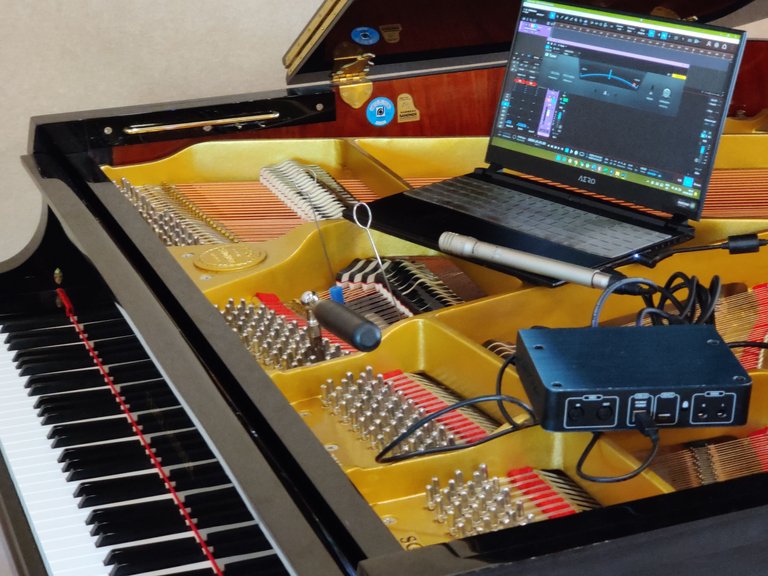
So for anyone who needs to but can't afford a professional - no problem! Just get a piano tuner (same as a drum key) and a couple of things to mute the strings, and you can pretty much do it yourself!
Here's How
So open the piano up and you are met with 88 strings... except it's way more. Only the lowest, thickest strings are solo. After a few notes from the bottom of the piano, each note starts to double up into pairs, and then triplets all the way to the top - giving a total of 230 strings. Yeah, you gotta tune 230 strings, one by one. There's no shortcut.
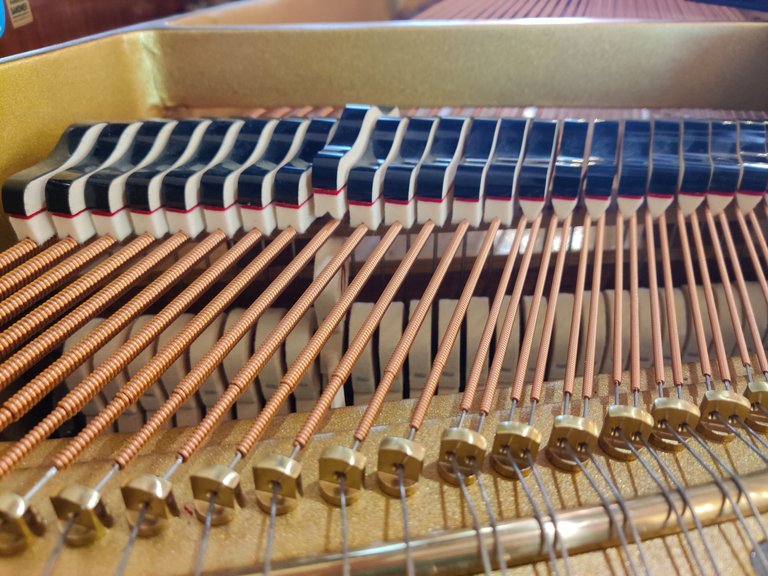
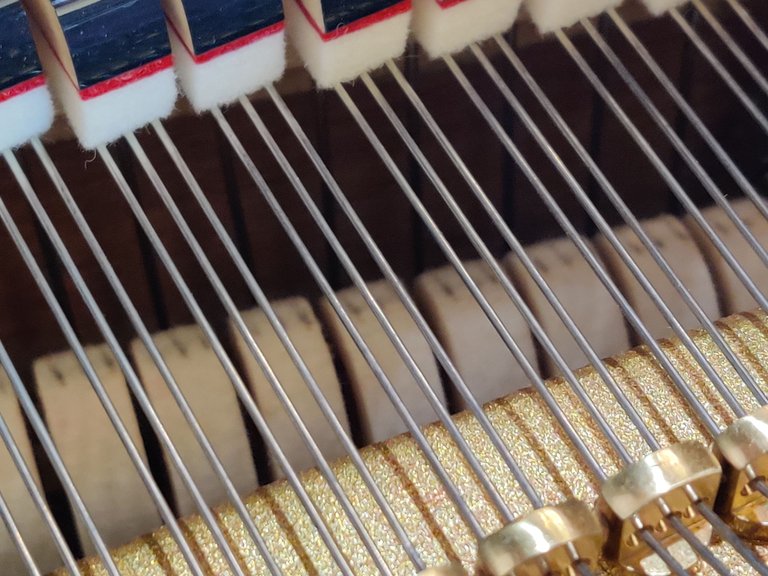
Thankfully the strings are set pretty sturdy and aren't influenced by the tension of other strings, like how a guitar's neck warps very slightly due to the change in tension, de-tuning your progress. A professional guitarist might find themselves tuning each string 2 or 3 times to get 'em just right. Not so with a piano. Once is enough.
But that's about the only saving grace. When it comes to the double string or triple string keys, each of them have to be perfectly in tune. If not, you get that kinda honky-tonk, drunk piano sound in old saloon bars (personally, I like this sound and was tempted to deliberately sabotage the piano in this way for flavour).
The reason for this is easily understood if you know that sound moves in waves. A higher pitched sound has a faster wave - a higher frequency of waves per second - and lower pitch has slower. If two strings are 99.5% identical, then one is expressing soundwaves 0.5% more often than the other, causing each wave to clash, out of sync with each other, which creates a gnarly dissonance.
This again can be a desirable effect. The reason a whole violin section in an orchestra sounds so extraordinarly different from a solo player is for this reason. Each player is slightly out from the next (no frets!) and all players are wobbling their fingers in different ways (vibrato), creating a chaotic slew of different wave frequencies clashing together to sum up, overall, to that warm orchestral sound we all love.
Unfortunately, each piano key isn't an orchestra of players, but only 2 or 3. Indeed, a violin duet is one of the hardest things to sound good. TWO players have the same problem as two strings on a piano. It's the worst of both worlds. Having one more player adds harmony and complexity, but you're exposed, unable to hide in the group, like two fish who got kicked out of the school. They're going to be the very first thing the dolphins gobble up, exposed in the open ocean. Weird metaphor but it works.
Anyway the point is, each string has to be perfect.
But if you know what to listen for, you actually don't even need a tuner to get this right.
This is not something I can demonstrate in text, but when two pithces are almost, but not quiet, in tune, you can physically hear those waves clashing with each other, in a kind of wobbling sound as they go in and out of sync. If you imagine one wave doing 2 full wobbles in 1 second, and the second does 3 wobbles in 1 second, then you can expect them to align every second, being otherwise out of sync for the other 0.9 seconds.
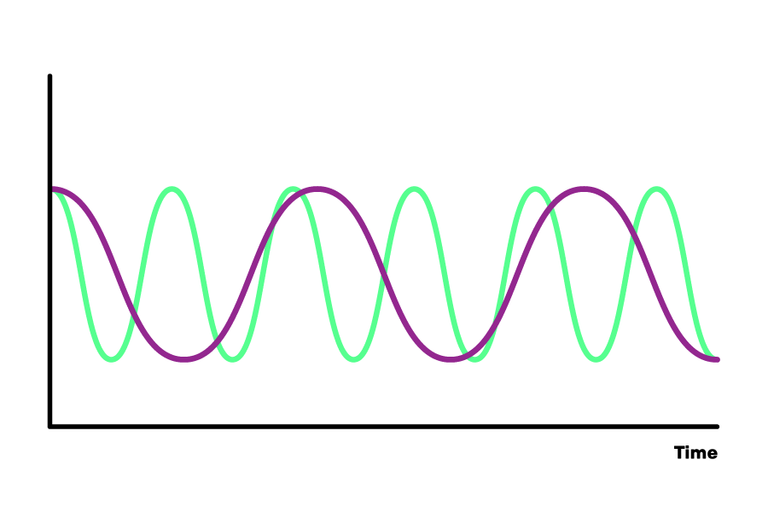
The closer in tune the strings become, the slower that wobble gets, until eventually it disappears, and the note no longer sounds like there are 2 or 3 strings, just a thicker-sounding, single note. This is also how guitarists tune their strings by ear, by listening for that wobble and adjusting until it fades away.
This is easy with two strings, harder with 3. With 3 - the majority of the piano - you will always have 2 wobbles out of sync with a third, making it impossible to distinguish with your ears or a tuner.
**That's what the mutes are for **
Nothing professional needed here, but they tend to be triangular little rubber wedges (with some larger ones you can use for certain annoying places in the piano) that you can silence one or two other strings, isolating to taste.
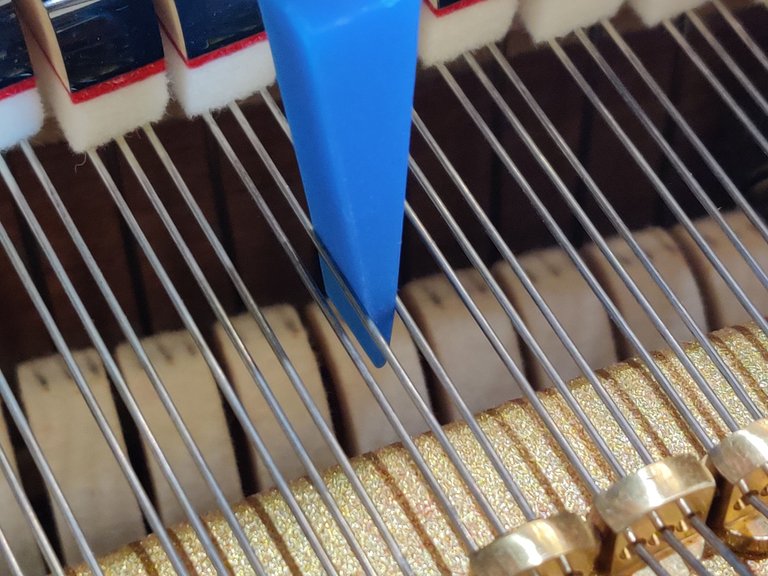

The rest is history. You put the hammer on one of these keys - try really hard not to get the wrong one. If you put the hammer on the wrong one, which is unsurprisingly easy to do, you might risk turning one like crazy, wondering why it's not changing pitch, before the whole thing snaps and replacing a piano string... I'd rather not think about.
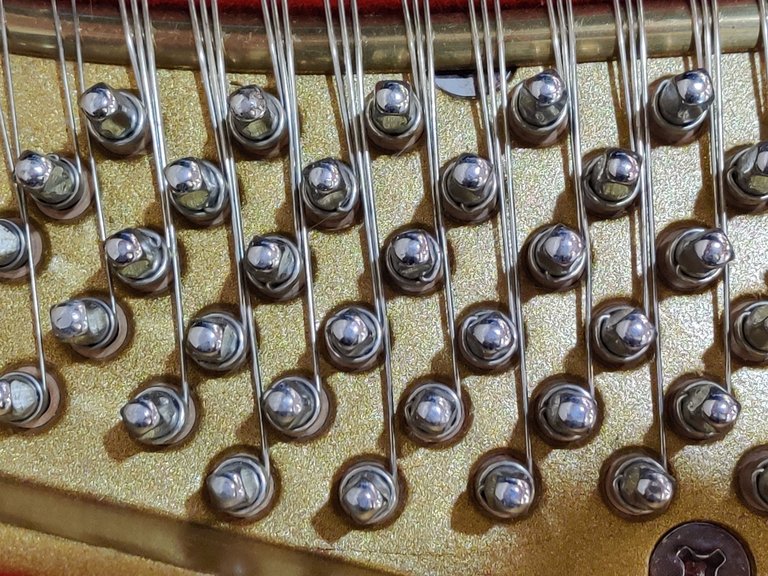
These things are pretty hard to turn, which means they're also hard to turn delicately. When you want to change the pitch by 1%, you can easily overshoot and have to go back the other way. This can be a handy technique actually, but often undesirable. Sometimes I have to properly whack the hammer with my palm or use a portion of my bodyweight to get it to turn. But that's ok. It's by design, otherwise they'd go out of tune every day.
So yeah you just do that 230 times, come back after a few days and maybe do some more again, and bob's your uncle!
Except... not quite. You see, the extreme low and high keys are pretty difficult to tune. With the bottom keys especially, I find the wave frequency to be so sluggish that it's really hard to hear with your ear. You have no secondary string to compare with and the tuner just goes crazy, as the pitch of the string changes as the initial attack weakens.
So there are some other techniques such as waiting for a second, playing octaves (the other note that's the same but higher pitch on another key) and such, but it's definitely the biggest struggle for me and I'm still not 100% satisfied.
The uppermost keys have their own problems as they're so thin and weak, they barely sustain long enough for a tuner to pick up their pitch to begin with.
There's also an argument to be had about tuning the lower strings slightly higer than 'correct', and then roll round to slightly lower than correct in the highest keys. I'm not entirely sure why but it's one some piano tuners do. Maybe @mipiano can explain it. Probably related to how the tuning system we all use is inherently imperfect.
Ok well I thought this was going to be a 300-word blog. I wish i'd shut up sometimes.
Wow i move the post and piano and it looks really beautifull inside
I'm always fascinated by the insides, it's so alarmingly complex XD
Exactly
Congratulations @mobbs! You have completed the following achievement on the Hive blockchain And have been rewarded with New badge(s)
Your next target is to reach 600 posts.
You can view your badges on your board and compare yourself to others in the Ranking
If you no longer want to receive notifications, reply to this comment with the word
STOPTo support your work, I also upvoted your post!
Check out our last posts:
That's some crazy work you've done! But no doubt the results are great.
Even though I love crafting things or tunning things up, I won't ever see myself doing this to a piano, so hats off for all your efforts and creativity!
Haha I wouldn't normally but the staff responsible for such things are pretty useless so... if you want a job done properly, do it yerself!
Plus its just a fairly useful skill for a musician to have generally I guess =D
Absolutely! 😁
Great explanation of phase!
When tuning guitar I tend to tune up, in other words, if I make a string too tight, I preffer to detune it a bit and retighten until it matches the reference string. I Find it stays in tune a bit longer. Do you do this with a piano?
Thanks! For me, and I think common practice, is the opposite but same in principle kinda, in which you tune it a tiny bit sharp first, and then return it down softly on pitch - for I think complicated mechanical reasons XD
I'm not exactly going for my tuner's license so the whys were never too much of a conern heh
I got to tell you, friend @mobbs , this is a special post. I mean, when I was a child I used to ask to myself how a piano should be tune... More than a few decades later, I'm having the answer... Lovely, curious, delightful, friend, hahaha. Nice post, mate!
Oh, well, happy to serve your childish wonder!
Life is just like this, mate! One day you wonder about things and the next the answer is right there, haha. Nice post, friend.